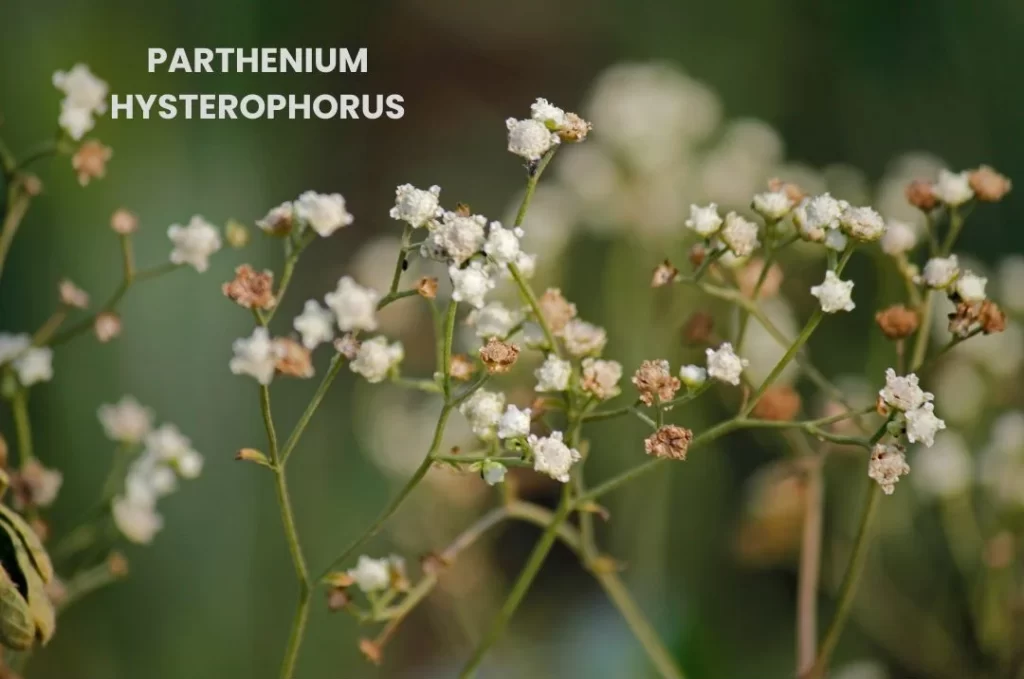Parthenium hysterophorus, commonly known as Bitter-broom or Escoba Amargo, is a plant traditionally used in Cuban medicine.
It is particularly valued for its effectiveness in treating fevers, especially those of malarial origin.
This remedy is also noted for increasing the flow of milk, addressing amenorrhea (absence of menstruation), and alleviating general debility.

Table of Contents
ToggleSOURCE INFORMATION
Scientific classification
- Kingdom: Plantae
- Order: Asterales
- Family: Asteraceae
- Genus: Parthenium
- Species: Parthenium hysterophorus
Origin and Historical Facts
- Origin: Native to the tropical Americas, Parthenium hysterophorus has spread to various regions worldwide, often considered an invasive species.
- Historical Usage: Historically, this plant has been used in traditional medicine for its febrifuge (fever-reducing) properties.
- It is particularly known in Cuban traditional medicine for its ability to treat malaria and other fevers.
- Medicinal Uses: Beyond its antimalarial properties, Bitter-broom has been used to stimulate milk production in lactating women and to treat amenorrhea and general physical weakness.
DRUG PATHOGENESIS
- Parthenium hysterophorus primarily acts on the head, eyes, ears, and abdomen.
- It is effective in reducing symptoms associated with fevers, particularly malarial fevers, and has notable effects on improving lactation and menstrual function.
- It also shows efficacy in treating respiratory issues such as Cheyne-Stokes breathing (a pattern of periodic breathing).
KEY CHARACTERISTICS
- Fevers: Effective in treating malarial fevers and fevers in general.
- Lactation: Increases the flow of milk in lactating women.
- Menstrual Issues: Used for treating amenorrhea (absence of menstruation).
- General Debility: Alleviates general physical weakness and debility.
- Respiratory: Can address Cheyne-Stokes breathing patterns.
DETAILED ORGAN SYMPTOMS
HEAD
- Headaches extending to the nose, often with a swollen sensation.
- Pain localized in the frontal eminence (forehead).
EYES
- Heaviness in the eyes with aching eyeballs.
- Disordered vision.
EARS
- Ringing in the ears (tinnitus) and pain.
NOSE
- Pain at the root of the nose, often with a swollen feeling.
TEETH
- Aching in teeth, with a sensation of teeth being on edge or too long.
ABDOMEN
- Pain in the left hypochondrium (upper left abdominal area).
- Affections of the spleen.
MODALITIES
- Worse: After sleep, sudden motion.
- Better: After rising, and walking about.
WHAT ARE MODALITIES IN HOMOEOPATHY?
RELATIONSHIP WITH OTHER DRUGS
Compare
- China (Cinchona): Known for its effectiveness in treating malaria and fevers.
- Ceanothus: Often used for spleen-related ailments.
- Helianthus: Utilized for its various medicinal properties, including anti-inflammatory and febrifuge effects.
DOSE
- The dosage of Parthenium hysterophorus is typically determined based on the specific symptoms and individual response.
- Consultation with a qualified homeopathic practitioner is recommended for appropriate dosing.
Frequently Asked Questions
What is Parthenium hysterophorus used for?
- Parthenium hysterophorus is primarily used to treat fevers, especially malarial fevers.
- It also helps increase the flow of milk in lactating women, addresses amenorrhea, and alleviates general debility.
Is Parthenium hysterophorus safe to use?
- When used under the guidance of a qualified homeopathic practitioner, Parthenium hysterophorus is generally safe.
- However, appropriate dosing and administration are crucial.
What are the side effects of Parthenium hysterophorus?
- Side effects are rare when used in recommended homeopathic potencies.
- Incorrect use or overdosing may lead to adverse reactions.
- Always consult with a homeopathic practitioner for proper guidance.
Glossary of Difficult Words
- Amenorrhea: The absence of menstruation.
- Cheyne-Stokes breathing: A pattern of periodic breathing characterized by alternating periods of rapid breathing and slow breathing or apnea.
- Febrifuge: A substance that reduces fever.
- Hypochondrium: The upper part of the abdomen on either side of the epigastrium, beneath the cartilage of the lower ribs.
- Tinnitus: Ringing or buzzing noise in one or both ears that may be constant or come and go.
